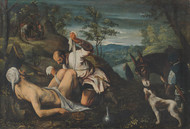Events / Exhibitions
07.12.2024 - 31.01.2025
Vahram Gayfejyan – 145․ At the Origins of Abstractivism
Vahram Gayfejyan (1879–1960) Is One Of The Founders Of Armenian Fine Arts And Artistic Education In The 20th Century. He Was A Prominent Representative Of Armenian Impressionism And One Of The First Armenian Modernists, Whose Art Was Shaped At The Beginning Of The 20th Century Within The Context Of Russian Avant-Garde, Becoming Part Of That Movement. Vahram Gayfejyan Is Also One Of The Founders Of Industrial And Urban Genres In Armenian Visual Arts.
Gayfejyan Was Born In Akhaltsikhe (At That Time Part Of The Tiflis Governorate Of The Russian Empire), A City That Inherited The Historical Centers Of Armenian Culture, Ani And Karin, In The Family Of The Enlightened Priest And Educator Ter-Mkrtich Gayfejyan.
From 1891 To 1911, The Artist Lived And Worked In Moscow, Where He Studied At The Lazarev Institute, Moscow University (Graduating From The Faculty Of Law), And The Moscow School Of Painting, Sculpture, And Architecture. From 1912 To 1924, He Lived And Worked In Akhaltsikhe, Abastumani And Tiflis, Where He Was Involved In Educational And Social Activities, Actively Participating In The Armenian Artistic Life, Which Was Centered In Tiflis.
In 1924, At The Invitation Of The Government Of Soviet Armenia, Gayfejyan Moved To Yerevan To Head The Newly Established Art School (Now Known As The P. Terlemezyan Art College), Where He Taught For Nearly 30 Years, Making An Invaluable Contribution To The Development Of Armenian Visual Arts.
As A Representative Of "Bourgeois" Art, Gayfejyan Miraculously Escaped Stalin's Purges. However, Unfortunately, He Could Not Save Many Of His Beautiful Pre-Soviet Modernist Works.
This Exhibition, Dedicated To The 145th Anniversary Of Vahram Gayfejyan, Mostly Presents The Series "Decorative Motifs" And "Colour Compositions" (1902–1907), Which Are Exceptional Gems From The Early Moscow Period Of The Artist’s Art Nouveau And Symbolist Style. During His Lifetime, The Artist Kept These "Dangerous" Works Secret, And Only After His Death Did His Daughter, Art Historian Ellen Gayfejyan, Discover Them, Make Them Public, And Study Them. In His Youth, Gayfejyan Was Deeply Engaged With The Programmatic Ideas Of The Art Nouveau Era, Seeking Through A Radical Renewal Of Artistic Language, Associative And Intuitive Reflections, To Reveal The Inner, Invisible, Spiritual Essences And Feelings. In This Process, The Visual Form Merges With Music, Prefiguring The Ideas Of Synesthesia Introduced By The Founder Of Abstractionism, Wassily Kandinsky. A Sensitive Intellectual, Gayfejyan Approached Abstract Art Several Years Before Kandinsky, But His Experiments, Due To External Circumstances, Did Not Continue. However, In These Miniature Masterpieces, There Is An Aspiration For A Breakthrough Into Monumental Space, Which We Can Today See Through Their Digital Projection At An Enlarged Scale.
The "Decorative Motifs" And "Colour Compositions" Series Gayfejyan First Exhibited At The Second Exhibition Of The Union Of Armenian Artists In Tiflis In 1919, Where They Immediately Captured The Attention Of The Progressive Art Community Of The Time And Were Mentioned In The Press. In 1961 And 1972 They Were Presented At Posthumous Exhibitions Of The Artist In The Artists’ Union Of Armenia And The State (Now National) Gallery Of Armenia. The Introduction To The 1972 Exhibition Catalogue Was Written By Yervand Kochar, Who Highly Valued Gayfejyan’s Work. These Exhibitions, Along With The Artist's Artistic Legacy, Had A Significant Impact On The Development Of National Modernism In Armenia During The Second Half Of The 20th Century, As Evidenced By Numerous Documentary Testimonies.
In 1943, Gayfejyan Was Awarded The Title Of Honoured Teacher Of The Armenian Ssr, And In 1954, The Title Of Honoured Art Worker. However, The True Recognition Of This "Quiet Genius" (As Art Critic Henrik Igityan Called Him) Came From Many Prominent Armenian Artists Who Studied Under Him And Drew Inspiration From His Work.
Vahram Gayfejyan Is One Of Those Artists Who Bestowed A Noble Radiance On Armenian Visual Arts And Elevated It To The Level Of European Modernist Art.
Curator: Lilit Sargsyan
